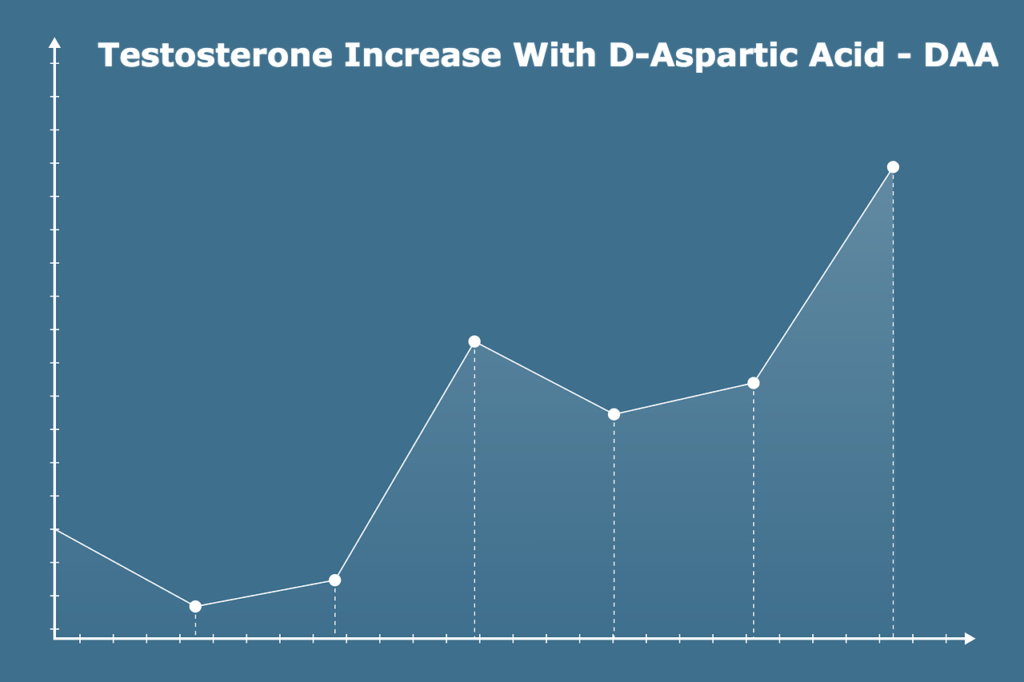 Testosterone is a powerful hormone linked to muscle building, fat loss, increased stamina, recovery, and overall sports performance. Therefore, having more of it will only benefit you one way or another.
Testosterone is a powerful hormone linked to muscle building, fat loss, increased stamina, recovery, and overall sports performance. Therefore, having more of it will only benefit you one way or another.
But, how can we increase our T naturally and safely? D-Aspartic Acid (DAA) has shown to boost testosterone production in the endocrine system – which is exactly what I’ll discuss in this article.
The mechanism of DAA works by stimulating the release and production of chemicals in your endocrine glands. While there are numerous glands in your body that release and create hormones, the ones responsible for the majority of T production are your testicles.
In basic terms, DAA works by stimulating activity in your brain to release the following; luteinizing hormone, follicle-stimulating hormone, and growth hormone.
Table of Contents
Benefits of D-Aspartic Acid and Testosterone Production
As previously mentioned, an overall increase in testosterone can be seen when using DAA. It’s been shown to increase your body’s ability to produce more testosterone. Therefore, using DAA has the potential to deliver the following results:
- Muscle growth and muscle retention – Increased free flowing T directly improves muscle size and strength.
- Heightened sexual arousal and stamina – Testosterone is the major male sex hormone, therefore, having more of it increases sexual drive and desire.
- Improved cognition – Low testosterone in men is linked to depression and poor cognitive function. Improving T with DAA will help to offset this effect.
- Faster recovery – When T enters the muscular system, it speeds up recovery, both short term during activity and during rest time (post day/s recovery).
- Assisted fat loss – Testosterone is well-known to help stimulate the release of lipids (fats) to be used as an energy source. Thus speeding up fat loss.
What is D-Aspartic Acid?
D-Aspartic Acid is a non-essential amino that can be found in mineral-rich soil (not easy to find due to constant land aggravation – more of a reason to supplement with DAA). It’s been shown to help stimulate the production of hormones from glands that are connected to testosterone release – hence its rise in popularity as a testosterone enhancing supplement.
How D-Aspartic Acid Increases Testosterone?
 When D-Aspartic Acid enters your body, it accumulates in neuroendocrine tissues, such as the pituitary gland, pineal gland, and gonads (testes and ovaries). It’s there, that DAA gets to work. As I’ve already mentioned, one of the main hormones that’s increased is Luteinizing hormone LH, which gets turned into testosterone. Therefore, the more LH you can produce with DAA will then provide more T.
When D-Aspartic Acid enters your body, it accumulates in neuroendocrine tissues, such as the pituitary gland, pineal gland, and gonads (testes and ovaries). It’s there, that DAA gets to work. As I’ve already mentioned, one of the main hormones that’s increased is Luteinizing hormone LH, which gets turned into testosterone. Therefore, the more LH you can produce with DAA will then provide more T.
To explain this further, LH is released from the pituitary gland signalling the release of testosterone from the testicles. As you can imagine, the more testosterone you’re able to create (for both men and women) the quicker you’ll recover, the more energy you’ll have, the more fat you’ll lose, and the more muscle you’ll be able to create.
How Much D-Aspartic Acid to Increase Testosterone?
The studies show that using lower doses of DAA are more beneficial than taking upwards of 6 grams p/d, which you might find in most supplements. (I) Let me explain:
After analysing the research, it suggests to me that taking smaller doses are most effective. Why is this? It’s because DAA is a testosterone raw material. In other words, it’s a nutrient required by the body to manufacture a hormone like testosterone. And, if too much is present, the body will remove unnecessary amounts.
As athletes who use supplements, we should be focusing on providing our body with the right amount of nutrients it needs to maintain optimum T levels all year round. This can be achieved with smaller doses at roughly 300 mg per day.
D-Aspartic Acid Testosterone Studies
D-Aspartic Acid Luteinizing Hormone and Testosterone Production
One study, which tested men and rats showed an overall increase in luteinizing hormone (LH) and testosterone production. Quoting the study: “In humans and rats, sodium D-aspartate induces an enhancement of LH and testosterone release.” (III)
 This all happens in messenger cycles that work in combination to stimulate the production of both LH and testosterone at the same time.
This all happens in messenger cycles that work in combination to stimulate the production of both LH and testosterone at the same time.
So what does this mean exactly? This means that D-Aspartic Acid will not only increase the ‘release’ of already produced LH and T. But, it will also stimulate further production of these powerful muscle building and sport enhancing sex hormones.
D-Aspartic Acid Sperm Quality and Reproductive Health
While DAA can improve testosterone levels, it can also increase sperm quality and amount. In a study which tested 30 men with the condition asthenozoospermia (reduced sperm mobility), found that DAA did, in fact, improve their condition.
Quoting the study; “We found that the supplementation of D-aspartate significantly increased the concentration and the motility of spermatozoa.” (IV) So, what does this information tell us? This shows us that anyone with low T or low sperm quality, mobility, or sexual health for that matter, can use DAA with great effect.
Sport Nutrition Recommendation?
 For a way to increase your strength, lean muscle mass, fat loss, along with focus and confidence, DAA has been shown to regulate the release of LH and testosterone which is linked to all of these benefits.
For a way to increase your strength, lean muscle mass, fat loss, along with focus and confidence, DAA has been shown to regulate the release of LH and testosterone which is linked to all of these benefits.
In my own trial of DAA, I found that I was able to retain muscle and strength for much longer. What’s more interesting is that I didn’t need to exercise as frequently to maintain my strength or bodyweight. This shows me that DAA can be used to increase strength and performance with less effort.
I also saw that my body composition appeared more defined after several weeks of using this supplement. This could be down to the way increased levels of T improves the use of lipids for energy – even at rest. And, as you might have guessed, my sexual drive and stamina also increased.
For doses, aim to use between 300 – 2000 mg per day which helps your body to produce testosterone on a continuous basis- rather than a spike, and then a dip, that comes with larger doses.
References:
(I) D’Aniello, Gemma, et al. “D-Aspartate, a Key Element for the Improvement of Sperm Quality.” Advances in Sexual Medicine, Scientific Research Publishing, 31 Oct. 2012. (source)
(II) Melville, Geoffrey W, et al. “Three and Six Grams Supplementation of d-Aspartic Acid in Resistance Trained Men.” Journal of the International Society of Sports Nutrition, BioMed Central, 1 Apr. 2015. (source)
(III) Topo, Enza, et al. “The Role and Molecular Mechanism of D-Aspartic Acid in the Release and Synthesis of LH and Testosterone in Humans and Rats.” Reproductive Biology and Endocrinology: RB&E, BioMed Central, 27 Oct. 2009. (source)
(IV) “Stimulation of Steroidogenic Acute Regulatory Protein (StAR) Gene Expression by d-Aspartate in Rat Leydig Cells.” FEBS Letters, No Longer Published by Elsevier, 9 July 1999. (source)
(V) D’Aniello, Gemma, et al. “D-Aspartate, a Key Element for the Improvement of Sperm Quality.” Advances in Sexual Medicine, Scientific Research Publishing, 31 Oct. 2012. (source)

Hey, let’s assume I use 600-1800 mg of D A A per day can then I then use it on a continuous basis without cycling?
Hi Arvind, I’m not sure why you’d want to go so high with the doses at 1600 mg – this could lower T production. It’s better to use smaller doses as you’ve suggested at 600-1000mg over a longer period. Doing it this way means you can use it ‘long-term’ without cycling. Have a look into this testosterone supplement I use. It contains just the right blend of ingredients to increase testosterone for the best long-term results https://performancelab.com/products/t-booster